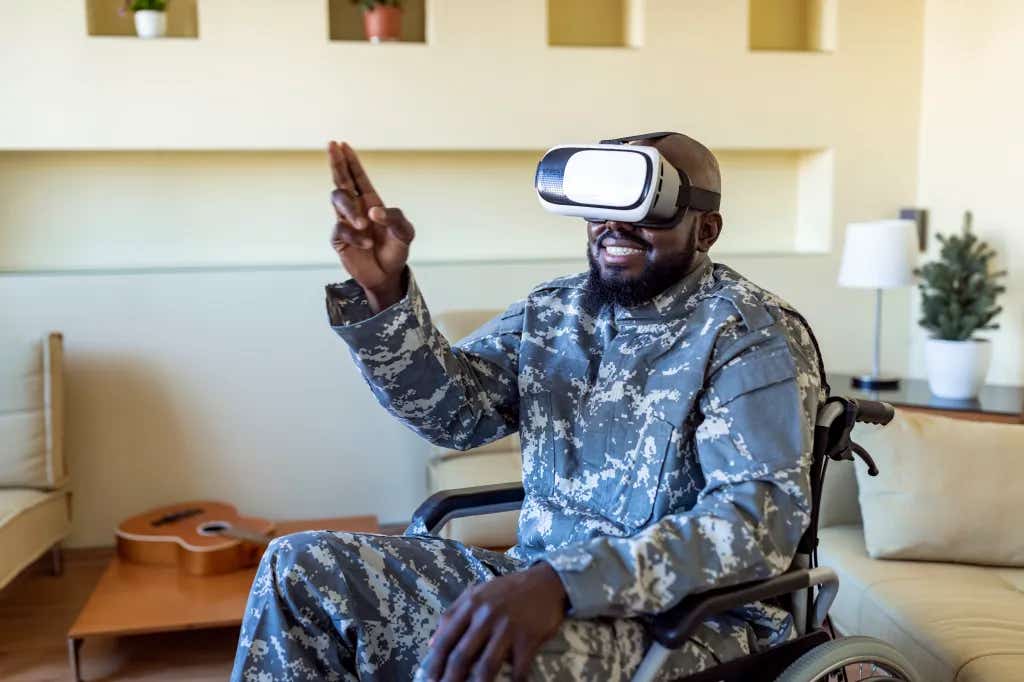Lifechanging therapy uses electric brain stimulation and VR to treat PTSD
Participants who underwent brain stimulation alongside virtual reality exposure reported a significant reduction in PTSD symptoms.

Participants who underwent brain stimulation alongside virtual reality exposure reported a significant reduction in PTSD symptoms. (CREDIT: Creative Commons)
A recent study suggests that combining two treatments could offer hope for individuals, particularly military veterans, grappling with the debilitating effects of post-traumatic stress disorder (PTSD).
Conducted at the Providence Veterans Affairs Medical Center, the clinical trial revealed that participants who underwent brain stimulation alongside virtual reality exposure reported a significant reduction in PTSD symptoms.
The findings, published in JAMA Psychiatry, mark a potentially groundbreaking approach to addressing the challenges in treating PTSD.
Skin conductance reactivity (nontransformed in microsiemens [μS]) across VR sessions (1-6) for active transcranial direct current stimulation (tDCS) plus virtual reality (VR) and sham + VR groups. Error bars represent SE. (CREDIT: JAMA Network)
Lead author Noah Philip, a professor at Brown University’s Warren Alpert Medical School, highlighted the significance of the study's results. He emphasized the innovative fusion of psychotherapy, neuroscience, and brain stimulation to enhance treatment outcomes. Philip, who spearheads mental health research at the Providence V.A. Center for Neurorestoration and Neurotechnology, expressed optimism about the promising implications of the findings.
PTSD, a prevalent psychiatric disorder characterized by intrusive thoughts, avoidance behavior, hyperarousal, and mood disturbances, presents significant hurdles in treatment, particularly among military veterans.
Traditional approaches such as trauma-focused exposure therapy and medication often fall short due to adverse effects and low patient tolerance. As Philip noted, up to half of patients withdraw from exposure therapy, citing its demanding nature.
Related Stories:
The study, led by Philip and Mascha van 't Wout-Frank, an associate professor at the Warren Alpert Medical School, sought to address these challenges by combining transcranial direct current stimulation (tDCS) with virtual reality exposure.
Van 't Wout-Frank, an investigator at the V.A. Providence Center for Neurorestoration and Neurotechnology, explained that exposure therapy aims to reprocess traumatic memories, enabling individuals to perceive formerly threatening stimuli as safe.
However, impaired brain function in PTSD patients inhibits effective safety learning, necessitating innovative interventions.
Clinical Outcomes Over Time. Scores indicate nonimputed (raw) values over time. Error bars represent SE of the mean. (CREDIT: JAMA Network)
TDCS, a non-invasive technique involving the application of low electrical currents to specific brain regions, holds promise in augmenting exposure therapy. By enhancing neural activity, tDCS may facilitate top-down control mechanisms, improving safety learning processes. Combining tDCS with virtual reality exposure, which offers immersive sensory experiences simulating real-world scenarios, presents a novel approach to PTSD treatment.
The study, conducted among 54 U.S. military veterans with chronic PTSD, assigned participants to either active tDCS or a sham treatment. Those receiving active tDCS underwent six sessions of virtual reality exposure over two to three weeks, during which low-level electrical currents targeted the ventromedial prefrontal cortex.
Combining tDCS with virtual reality exposure, which offers immersive sensory experiences simulating real-world scenarios, presents a novel approach to PTSD treatment. (CREDIT: Creative Commons)
Results demonstrated a significant reduction in self-reported PTSD symptom severity among active tDCS recipients compared to the sham group, indicating accelerated psychological and physiological adjustment.
Philip highlighted the advantages of virtual reality exposure, emphasizing its ease of use compared to traditional therapy. By immersing participants in simulated trauma-inducing environments, virtual reality circumvents the need for individuals to recount personal traumas repeatedly, a common barrier in therapy adherence.
Remarkably, the combined treatment achieved results in just two weeks, a process that typically spans 12 weeks with conventional therapy. Moreover, the effects persisted beyond the treatment period, with the most significant improvements observed one month post-treatment. Philip underscored the continued enhancement of outcomes over time, reflecting the treatment's sustained efficacy.
The research team intends to delve further into the study's findings to elucidate the underlying brain mechanisms and long-term effects of the treatment. Future endeavors will explore larger study cohorts, extended follow-up periods, and potential re-treatment effects, offering promising avenues for advancing PTSD management.
The clinical trial revealed that participants who underwent brain stimulation alongside virtual reality exposure reported a significant reduction in PTSD symptoms. (CREDIT: Creative Commons)
The integration of tDCS with virtual reality exposure represents a paradigm shift in PTSD treatment, offering a more accessible and efficacious approach for affected individuals, particularly military veterans.
As research progresses, such innovative interventions hold the potential to alleviate the burden of PTSD and enhance the well-being of those affected by this debilitating condition.
Note: Materials provided above by The Brighter Side of News. Content may be edited for style and length.
Like these kind of feel good stories? Get the Brighter Side of News' newsletter.



